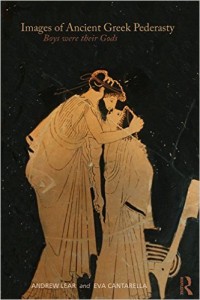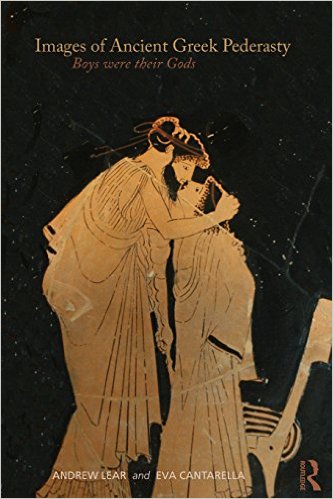 Images of Ancient Greek Pederasty: Boys Were Their Gods
Images of Ancient Greek Pederasty: Boys Were Their Gods
Andrew Lear and Eva Cantarella
Routledge. 272 pages, $115.00
THIS IS a timely book, with three reasons for existing. Images of Ancient Pederasty offers: first, the series of intelligent and resourceful essays by Lear and Cantarella on various aspects of the representation of pederasty in Athenian vase-painting; second, more than 110 illustrations of the most significant examples of the different typologies; and third, an appendix based on research undertaken by the late Keith DeVries, listing all, or nearly all, extant examples of pederastic and male homosexual scenes on Greek vases.
The scholar in me rejoices; why, then, does the æsthete despair? Partly because the illustrations, smallish and all monochrome, don’t improve in terms of quality upon those previously available. Googling many of these throws up superior virtual images. (Routledge, take note: this is certainly not a “lavishly illustrated” book.) Partly it’s the price. Evidently, the publisher considers this book to be exclusively of academic interest. By contrast, James Davidson’s recent tome, The Greeks and Greek Love (reviewed in the May-June issue of this journal)—still pricey at around $60—finds space for 58 illustrations among 600 pages of dense argument, and is able to range a little more widely than vases.
In a sense, Lear and Cantarella have simply proven unlucky. Though Davidson is credited among scholars whose ideas have informed their own, their manuscript must have been completed before The Greeks and Greek Love appeared. Consequently, many of their most compelling ideas—which follow to a large degree the new emphases in Davidson’s study, and reject much previous scholarship (Kenneth Dover, Michel Foucault)—were persuasive but familiar, at least to this reader. The general thrust of this new book is that in pederastic relations, “there was at least potentially a greater degree of reciprocity than our ancient [literary]texts admit, or than most modern scholars believe”—an argument similar to that of Davidson.
But there are also differences. A key shared subject is the familiar story of the friendship between Achilles and Patroclus, told in Homer’s Iliad and finely detailed on one exceptional vase, the Sosias Cup in Berlin. Lear takes note of “the great precision with which the age difference between them is indicated: … both have sideburns, but Achilles is smooth-cheeked, while Patroclus has a short beard and moustache, perhaps representing a new beard.” Davidson does not exactly dissent from this, but he drives the Sosias image with greater determination toward a more startling general claim that “there seems … to have been much less of an age-gap between couples in a same-sex relationship in ancient Greece than between heterosexual couples. It was certainly not “intergenerational” sex, and often involved a difference of just a few years.” Lear mildly argues that “this scene probably … intends their domestic intimacy as erotic.” Davidson brings out the many nuances that should astonish us:
Achilles is a beardless youth, a Stripling, but with the beard already appearing by his ears; indeed he seems to have raised his cheek-guard to show us his age. He kneels between Patroclus’ open legs. Patroclus is a bit older, bearded but not luxuriantly. … Patroclus’ genitals are prominent and the anonymous artist has taken great care to show the loose skin around his testicles, like an art nouveau flower design on a stained-glass window in Brussels, Barcelona, or Prague. He has shown the knuckles on the back of Achilles” hand, and the folds of his palm just visible on the other.
Scholarship needs the reserve of Lear and Cantarella, as careful in their close readings as John Addington Symonds was a century ago. But it also needs its Walter Paters and its Davidsons, replete with imaginative resourcefulness, pan-historical daring, and even moments of the absurd.
Perhaps some nervousness attending even the discussion of this topic shouldn’t surprise us by now. The book’s abstract reassures the reader that this complex (and inevitably still partly obscure) Greek phenomenon “has few modern parallels.” Hasn’t anybody at Routledge seen Jarhead?






